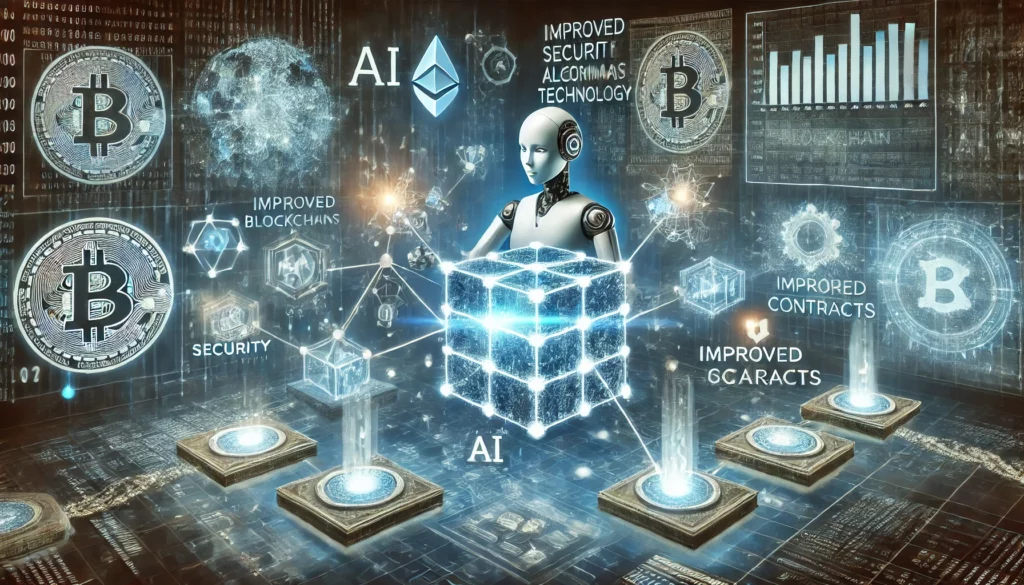The convergence of artificial intelligence (AI) and blockchain technology is reshaping how we think about data, security, and automation. While blockchain is celebrated for its decentralized and transparent nature, it also faces challenges in areas like scalability, security, and efficiency. AI, with its advanced analytical and learning capabilities, is emerging as a powerful tool to address these challenges and unlock new opportunities for innovation.
This article explores how AI is enhancing blockchain technology, with a focus on improving security, scalability, and smart contract functionality.
1. AI Enhancing Blockchain Security
Blockchain technology is inherently secure, relying on cryptographic techniques to protect data. However, vulnerabilities can still arise from human error, malicious attacks, or poorly designed protocols. AI offers advanced solutions to strengthen blockchain security:
Threat Detection and Prevention
AI systems can analyze vast amounts of data in real time, identifying patterns that indicate potential security threats. This is particularly valuable for:
- Identifying anomalies in transactions or network activity.
- Detecting and mitigating DDoS attacks or malicious nodes.
- Enhancing fraud detection in decentralized applications (dApps).
Improved Encryption
AI-driven algorithms can help improve cryptographic methods used in blockchain:
- AI can optimize key management systems, making it harder for attackers to exploit private keys.
- Machine learning can help design more robust encryption techniques, adding another layer of protection against hacking attempts.
Smart Contract Auditing
Smart contracts, while powerful, are prone to bugs and vulnerabilities. AI tools can:
- Automatically audit smart contract code, identifying weaknesses before deployment.
- Use machine learning to predict how contracts will behave in various scenarios, reducing the risk of unintended outcomes.
2. AI Solving Blockchain Scalability Challenges
Scalability is one of the biggest hurdles facing blockchain adoption. Popular networks like Bitcoin and Ethereum often struggle with slow transaction speeds and high fees during periods of congestion. AI can help address these issues in the following ways:
Optimizing Consensus Mechanisms
Blockchain networks rely on consensus algorithms (e.g., Proof of Work, Proof of Stake) to validate transactions. AI can improve the efficiency of these processes by:
- Predicting network congestion and adjusting parameters dynamically.
- Optimizing resource allocation to ensure smoother operations.
Layer-2 Scaling Solutions
AI can enhance layer-2 solutions, such as rollups or sidechains, by:
- Monitoring and predicting transaction volumes to prevent bottlenecks.
- Automating the off-chain processing of transactions, ensuring faster execution.
Dynamic Resource Allocation
AI can allocate computing resources dynamically based on network demand, improving throughput without compromising decentralization.
3. AI Advancing Smart Contracts
Smart contracts are self-executing programs on a blockchain, but they are often limited by their deterministic nature and lack of flexibility. AI can transform how smart contracts are created, executed, and optimized:
Smarter Decision-Making
By integrating AI, smart contracts can:
- Analyze external data (e.g., market trends, weather conditions) in real-time to make more informed decisions.
- Adapt dynamically to changes in their environment, increasing their functionality and relevance.
Natural Language Processing (NLP)
AI-powered NLP tools can translate complex legal or business terms into smart contract code, simplifying the creation process for non-technical users.
Enhanced Automation
AI can expand the automation capabilities of smart contracts by:
- Using predictive analytics to anticipate user behavior and automate responses.
- Interacting seamlessly with IoT (Internet of Things) devices, enabling smart contracts to trigger physical actions in real-world environments.
Use Cases: AI and Blockchain in Action
1. Financial Security
- AI-powered blockchain systems can monitor transactions to detect fraud in real-time, improving trust in decentralized finance (DeFi) applications.
- Automated trading bots driven by AI can execute more efficient trades on blockchain-based platforms.
2. Supply Chain Optimization
- AI can analyze blockchain data to optimize supply chain logistics, ensuring transparency and efficiency.
- Predictive analytics can forecast demand and reduce waste.
3. Healthcare Data
- AI enhances the use of blockchain for securely sharing medical records, enabling predictive healthcare solutions while maintaining patient privacy.
4. Energy Management
- AI can optimize energy distribution on blockchain-based grids, reducing costs and improving sustainability.
Challenges in Combining AI and Blockchain
While the integration of AI and blockchain offers immense potential, it is not without challenges:
- Data Privacy: Sharing data between AI and blockchain systems may raise privacy concerns.
- Computational Costs: Both technologies require significant computational resources, which can increase costs and energy consumption.
- Interoperability: Ensuring seamless interaction between AI algorithms and blockchain protocols requires advanced development.
The Road Ahead – AI in Blockchain
The fusion of AI and blockchain is still in its early stages, but it holds transformative potential across industries. By enhancing security, improving scalability, and unlocking new functionalities in smart contracts, AI can address some of the most pressing challenges facing blockchain technology.
As AI continues to evolve and blockchain networks adopt more sophisticated solutions, the synergy between these technologies could drive the next wave of innovation, making decentralized systems smarter, faster, and more secure than ever before.


